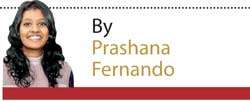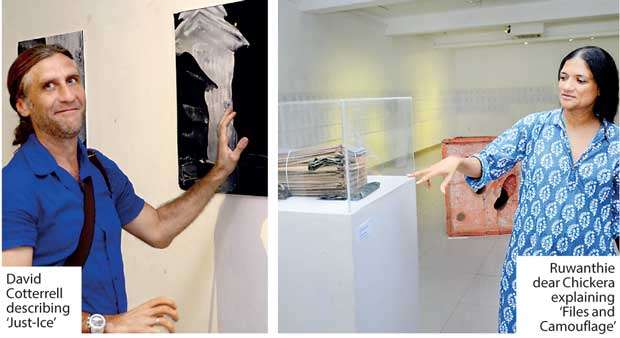25 Dec 2018 - {{hitsCtrl.values.hits}}

 Recognising World Human Rights day celebrated on December 10, four contemporary artistes joined forces to respond to the current political travesty raging the nation. Presenting both their own creative take on this chaos and a platform for voices of resistance to rise up, Chandragupta Thenuwara, Senaka Weeraman, David Cotterrell and Ruwanthie de Chickera held ‘Human Rights Arts 2018’ from December 10 to 15 at the JDA Perera Gallery marking its second year.
Recognising World Human Rights day celebrated on December 10, four contemporary artistes joined forces to respond to the current political travesty raging the nation. Presenting both their own creative take on this chaos and a platform for voices of resistance to rise up, Chandragupta Thenuwara, Senaka Weeraman, David Cotterrell and Ruwanthie de Chickera held ‘Human Rights Arts 2018’ from December 10 to 15 at the JDA Perera Gallery marking its second year.
The venture’s circulars pictured the faces of President Maithripala Sirisena, Prime Minister Ranil Wickremesinghe and former President Mahinda Rajapaksa morphing into one; a statement of impartiality and equal compromise. The showcase placed sensitive issues in bold new light and was profound evidence that violence and uproar aren’t the only means to make a stand.
Walking into the ground floor, one first encountered the works of Chandragupta Thenuwara; President of the Arts Council of Sri Lanka and Senaka Weeraman, a local architect based in London.
In an attempt to address the misinterpretation of the Constitution concerning its translations, Thenuwara had reprinted the document in English, Sinhala and Tamil and spanned them across the wall one below the other. “For some reason, the same content ends up having to take a lot more words to explain,” Cotterrell mentioned gesturing to the length disparity of the translations.
Amidst the cacophony of contradiction, one may come to realize that “depending on where you stand you have a different understanding of what this picture means.”
Weeraman also followed the tri-lingual theme in his artwork proclaiming the words “Democracy + Justice” employing a unison of red, blue and green colours.
Installation artist and director David Cotterrell together with playwright and theatre director Ruwanthie de Chickera tackled the Constitutional issue somewhat differently. The work titled, “Capital C for Constitution” playfully responded to the recent debate over the meaning of clauses of the constitution. As both parties involved presented their mandate claiming constitutional evidence, this piece delivered that subtle differences in the Sinhala and English versions might serve to have profound consequences. A computer administered by an unseen entity used Google to translate the document between the three languages. The process continued, the small flaws in the automatic translation began to take effect, until finally the absent operator inserted the selection back into the official document when it was no longer perceived as a threat. Cotterrell explained that they were trying to “highlight the possibility of error, the possibility of making mistakes.”

Another thought provoking piece by this pair who have been around the world collaborating for the past three years, was titled ‘Was Many pictures.’ This incorporated six lecterns which surrounded a single monochrome photograph capturing the moment former president Mahinda Rajapaksa signed his acceptance of the Prime Ministerial office. This iconic image that was plastered all over media and broadcast for the world to see was always accompanied by an opinion, quote; a caption of some sort, until now. Here, the artists invited the viewers to observe the image in silence, unrestricted by a framework of an outsider’s thoughts. One might then approach the six lecterns containing a catalogue of audio clips extracted from reprinted stories within the Daily Mirror. Random, unrelated and even contradictory statements and reports of the capture would then be read out by actors. Amidst the cacophony of contradiction, one may come to realize that “depending on where you stand you have a different understanding of what this picture means.” Referring to the piece, its creators explained, “It seems we share the same pictures but not the same narratives. In fact, in spite of us sharing the same pictures, and even forming our narratives through common pictures, it’s entirely possible that we inhabit parallel realities, comprising parallel memories and building on parallel imagined futures. Many pictures became one picture because we realized one picture could literally hold the hopes and fears of an entire country.
”political ‘heroes’
Amidst the artistic statements made in connection to the ongoing political crisis, there were also references to Sri Lanka’s history of war, turmoil and chaos. Chandragupta Thenuwara’s “Fallen Heroes after October 26 (2018), Black Friday;”pointed to a mould used to sculpt a monument now split at its core. Deceptively simple in appearance, the work delivered a message of broken and hollow ideals of heroism. It described how political ‘heroes’ are now exposed, humiliated and made immaterial before the eyes of the masses that once placed them on pedestals. Having previously launched his series on ‘barralism’ which provided a creative outlook on the concrete barricades behind which soldiers stood during the time of war, Thenuwara’s ‘Neo-barralism Strikes back’ served as a reminder of how barrels and barricades have existed and have weakened since, trying to suppress chaos from breaking free. A similar line of thought was seen through his piece ‘Files and Camouflage,’ where a stack of filed human rights violation cases were mingled with scraps of camouflage material, expressing a concealed, yet always present interference with the system.
Capturing the attention of crowds both online and at its unveiling was David Cotterrel and Ruwanthie de Chickera’s “Just-Ice”- a six-foot tall ice sculpture of the Parliament building. The ambitious yet successful structure was constructed twice; once at the Independence square and then again for the opening day of the exhibition.
Cotterrell described their adventurous reveal at the independence square, where they observed its effect on the masses. Some took selfies, protest groups used it to support their causes, children wanted to touch it, it caused quite the stir, he explained. And all the while, the carving was melting-implicatively from within.
“Parliament took a long time to dissolve. People kept vigil. Some lit candles. Some sang songs. But there was a sense that the inevitable was happening. Parliament was collapsing. It seemed to collapse from the inside. There was a gasp from the people watching as the roof of parliament slid off. Without that shape, it began to look more vulnerable. Some people had trouble even identifying it as parliament,” the creative pair thus established the powerful message they were attempting to deliver.
A short time-lapse video which documented the symbolic melt-down was projected at the gallery during the course of the art festival. Ruwanthie added that ironically, the actual Parliament dissolved and collapsed faster than the ice sculpture, which lasted for almost 24 hours at its second unveiling.
Adorning this space were, banners, posters and pictures from various protest campaigns, gleaning like insignia of rebellious battles fought by the people for the people
The upper-most floor of the exhibition was made open for anyone who needed a platform to have their voice heard.
Adorning this space were, banners, posters and pictures from various protest campaigns, gleaning like insignia of rebellious battles fought by the people for the people. Decking the upper pillars was the momentous sari cloth proudly worn at the recent womens’ Protest and draped over a railing was the emblematic rainbow- flag carried by the LGBTIQ community of Sri Lanka in their recent campaign. A wall for the protests of the families of the disappeared, a section for the anti-torture movement, a platform for social media awareness and posters of the butterfly protestors filled up the premise. In this manner, completely unrelated and otherwise disconnected causes were allowed to claim their ground within a single space.
“The important thing is, this is going to be a regular thing every year, to encourage people to think about raising questions about politics, to make people have a debate and discuss...the whole point is to look at the system,” David Cotterrell expressed the intent driving this venture.
‘Human Rights Arts’ initiated in 2017 by Chandragupta Thenuwara primarily focuses on two specific articles of the Universal declaration of Human Rights.
Article 8 “Everyone has the right to an effective remedy by the competent national tribunals for acts violating the fundamental rights granted him by the constitution or by law”
Article 21 “Everyone has the right to take part in the government of his country”
It is in acknowledgement of these rights that this small but powerful collective of contemporary artists have united to view the national crisis through a new lens to express the unexpressed and to stand up for the fundamental values of humanity.
30 Nov 2024 3 hours ago
30 Nov 2024 4 hours ago
30 Nov 2024 7 hours ago
30 Nov 2024 9 hours ago
30 Nov 2024 30 Nov 2024